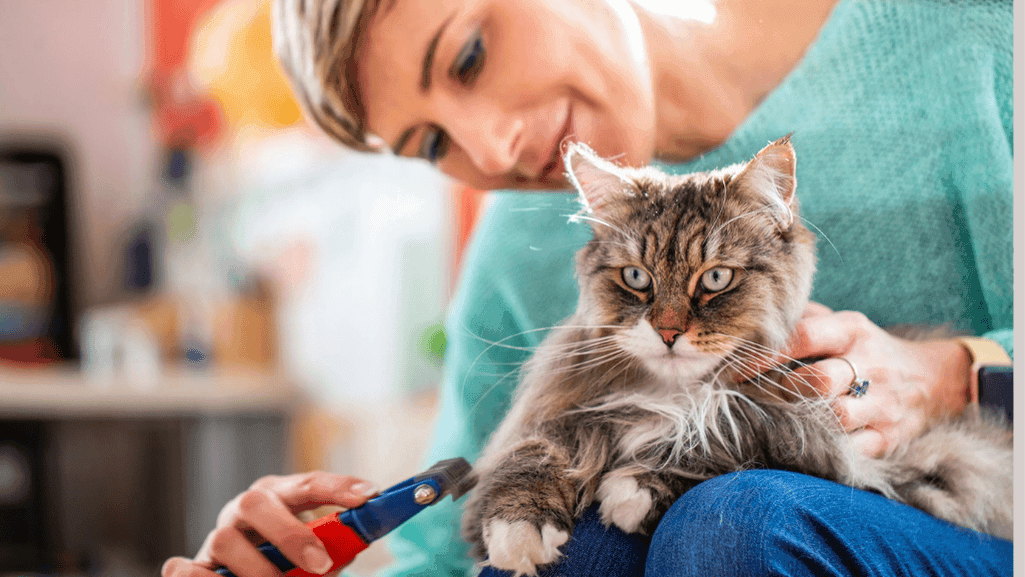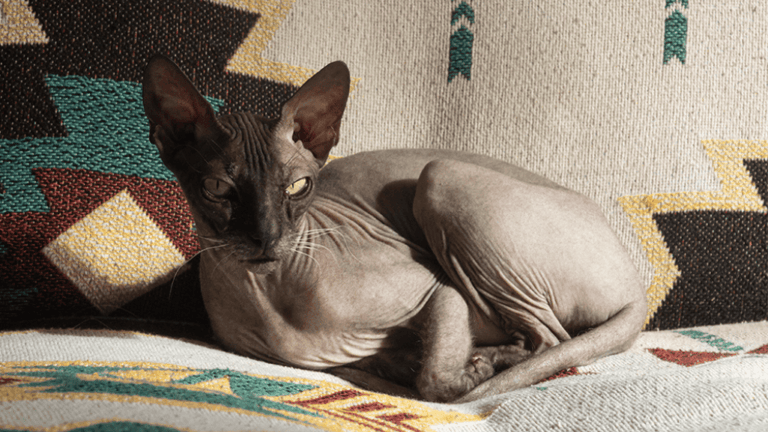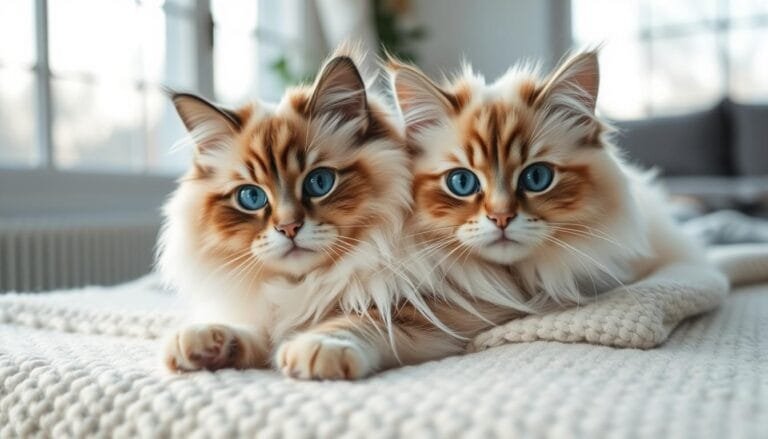Many dream of having a playful and loving kitten, but allergies often get in the way. Luckily, hypoallergenic kittens for adoption make this dream possible without the sneezes and itchy eyes. Cat allergies are common, but some breeds produce less of the allergenic protein Fel D1.
Adopting an allergy-friendly kitten can bring joy to those with allergies. It’s a chance to have a feline friend without the discomfort. Find your perfect match among hypoallergenic cats and enjoy a comfortable life together.
Key Takeaways
- Explore breeds that produce fewer allergens and adopt hypoallergenic kittens that fit your lifestyle.
- Understand the source of cat allergies and find suitable, allergy-friendly kittens adoption options.
- A smooth transition with an average kitten pickup waiting time of just 2 weeks.
- High satisfaction rates, with 100% of customers happy with their kitten’s health upon arrival.
- Responsive support from staff, ensuring your questions are answered within minutes.
- Enjoy peace of mind knowing that your kitten comes with all essentials: toys, food, and carrier.
Understanding Cat Allergies and Hypoallergenic Breeds
Many people dream of having a cat but are stopped by allergies. Luckily, there are now hypoallergenic cat breeds. These cats are perfect for those who want a feline friend but can’t handle regular cats. Learning about cat allergens and finding hypoallergenic breeds is key for allergy-prone families.
The Science Behind Feline Allergens
Most cat allergies come from a protein called Fel D1 in cat saliva. This protein can also be found in their fur and skin. Some cats make less of this protein because of their genes.
Things like the cat’s age, sex, and fur color can affect how much allergen they produce. For example, light-colored and female cats often make less allergen than dark-colored or male cats. Doctors are now saying that while no cat is completely hypoallergenic, some breeds are better for people with allergies.
Identifying Hypoallergenic Cat Breeds
Finding the right hypoallergenic kitten breed means knowing about their allergen production and grooming needs. Breeds like the Sphynx and Devon Rex have little fur and need regular grooming. This makes them good for people with allergies because they shed less.
Other breeds, like the Bengal and Russian Blue, also have lower levels of Fel D1. Below is a table showing different hypoallergenic cat breeds and their characteristics:
| Breed | Fur Type | Grooming Needs | Activity Level |
|---|---|---|---|
| Bengal | Short | Minimal | High |
| Sphynx | Bald/Peach Fuzz | High | High |
| Devon Rex | Short/Soft | Moderate | High |
| Cornish Rex | Curly | Moderate | Moderate |
| Javanese | Long | High | High |
| Balinese | Long | High | Moderate |
| Oriental Shorthair | Short | Low | High |
Knowing these traits helps people pick the right hypoallergenic kittens for their family. Regular grooming and using air purifiers can also help make life with these breeds easier for those with allergies.
The Benefits of Adopting Hypoallergenic Kittens
Adopting hypoallergenic kittens brings many benefits for those with allergies. It allows for a fulfilling pet experience without the usual allergic reactions. These kittens are perfect for many who can’t have pets because of allergies.
One big plus is they don’t trigger allergies as much. This is great for people with sensitivities. They can enjoy the love and support of a pet without sneezing, watery eyes, or stuffy noses.
Also, hypoallergenic kittens are known as some of the best hypoallergenic cats. They don’t have high levels of Fel d 1 allergens. Their grooming and physical traits help keep allergens low.
Breeds like the Balinese, Devon Rex, and Sphynx are good for allergy sufferers. They have special qualities that help them be hypoallergenic.
| Breed | Description | Benefits |
|---|---|---|
| Sphynx | Almost hairless | Minimal shedding reduces allergen spread |
| Devon Rex | Short, curly hair | Less shedding and lower maintenance |
| Balinese | Long-haired but produces less Fel d 1 | Attractive for those who prefer traditional cat appearance with fewer allergens |
Adopting from shelters also helps animals in need. It’s often cheaper than buying from breeders. These pets usually come spayed or neutered and vaccinated, saving on vet bills.
In conclusion, adopting hypoallergenic kittens is a great choice. They bring joy and reduce allergy symptoms. Plus, it helps animal welfare by supporting adoption and reducing shelter populations.
How to Find Hypoallergenic Kittens Near Me
If you want to adopt a hypoallergenic kitten, there are many ways to find the right one. You can use online platforms or local resources to find a kitten rescue or shelter.
Using Online Resources and Databases
Start by looking at online databases that list hypoallergenic kittens. These sites give you details on cats available for adoption, like their breed and age. They are updated often, so you can find the latest information.
Contacting Local Rescues and Shelters
Also, reach out to local shelters and rescue groups. They can help you find a kitten that fits your lifestyle and allergies. Visiting shelters lets you meet kittens and talk to staff about your needs.
Here’s what you can expect when adopting a cat:
| Type of Cat | Adoption Fee | Services Included |
|---|---|---|
| Domestic Cats | $75 – $175 | Spay/Neuter, Vaccinations, Microchipping, Deworming |
| Purebred Mix Cats | $125 – $250 | Spay/Neuter, Vaccinations, Microchipping, Deworming, Dental Cleanings |
| Purebred Cats | $150 – $500 | Spay/Neuter, Vaccinations, Microchipping, Deworming, Feline Leukemia/FIV Testing, Dental Cleanings |
| Rare Breed Purebred Cats | $300 – $600 | Spay/Neuter, Vaccinations, Microchipping, Deworming, Feline Leukemia/FIV Testing, Dental Cleanings |
Knowing the medical and care services included can make you feel confident about the cat’s health.
Try going to adoption events and visiting shelters. These places let you meet many kittens. It’s easier to find a cat that fits your needs.
Finding a hypoallergenic kitten is about more than just allergies. It’s about adding a loving pet to your home. Spend time with the kittens and talk to shelter staff. They can help you choose the right kitten for you.
Hypoallergenic Cats for Adoption: Top Breeds to Consider
Looking into hypoallergenic cats for adoption? Knowing the traits and benefits of certain breeds can help you make a better choice. This section focuses on two breeds that are favorites among those with allergies: the Balinese and the Siberian.
Characteristics of the Balinese Breed
Balinese cats have long, luxurious coats that are surprisingly hypoallergenic. They produce less of the Fel D1 protein, which is the main allergen in cats. This makes them a great choice for those with allergies. They weigh between 4 to 10 pounds and live for 12 to 15 years. They are known for being affectionate and sociable.
Advantages of the Siberian Cats for Allergy Sufferers
Siberian cats have a moderately long coat but are still hypoallergenic. They have lower-than-average enzyme levels in their saliva. Up to 75% of cat allergy sufferers don’t react to Siberians, making them a popular choice. These cats weigh between 17 to 26 pounds and live for 12 to 15 years. They are fun to be around and have a bold spirit.
Both breeds show the beauty and companionship that hypoallergenic cats can offer. They bring joy without the sneezing and itching that often comes with cat allergies.
| Breed | Weight Range | Lifespan | Character Traits |
|---|---|---|---|
| Balinese | 4 to 10 pounds | 12 to 15 years | Affectionate, Social, Lower Fel D1 Production |
| Siberian | 17 to 26 pounds | 12 to 15 years | Adventurous, Bold, Hypoallergenic for Most |
These hypoallergenic cats are great companions for those with cat allergies. Both Balinese and Siberian breeds have unique benefits. When adopting, it’s important to spend time with the cat to see if it’s a good fit, especially if you have allergies.
Pre-Adoption Measures for Allergy-Friendly Cats
Starting the hypoallergenic kitten adoption process requires careful steps. It’s important to know about and manage allergies, especially if you’ve had reactions to pets before.
Thinking about a hypoallergenic pet adoption is wise if allergies are a concern. Hypoallergenic cats, often seen as non-shedding, still carry allergens but in smaller amounts. Knowing how to manage these allergens can make adopting easier.
Meeting Potential Kittens: A Step Towards Smart Adoption
When meeting kittens, remember that allergies can affect people differently. It’s key to spend time with kittens before adopting. This lets you see how your body reacts, helping avoid surprises later.
Pay attention to how you react to different kittens. Things like age, gender, and fur type can influence how much allergen they produce.
Factors Affecting Allergen Production
The main cat allergen, Fel d 1, is made less in females and neutered males. Lighter-colored cats and kittens under one also make fewer allergens. Knowing this can help you choose the right kitten for your family.
Visiting shelters and talking about these options can help find the best fit. This leads to a successful hypoallergenic pet adoption.
To help manage allergies, consider using HEPA air purifiers and cleaning often. These steps are crucial for keeping allergens low, making it easier to enjoy your new pet.
Remember, adopting a cat is a big commitment. Taking these steps can help create a happy relationship with your new kitten. It makes pet ownership more enjoyable while keeping allergies in check.
Adopt Hypoallergenic Kittens: The Process Explained
Starting the journey of hypoallergenic kitten adoption is exciting and filled with joy. It’s a process that involves a reputable hypoallergenic kitten adoption agency. This ensures a smooth transition for both the kitten and the adopter.
First, you research hypoallergenic breeds that are less likely to trigger allergies. This helps when you visit shelters or contact breeders. You’ll know exactly what you’re looking for.
Next, you spend time with the kittens. This is important to see if you have any allergic reactions. It’s a crucial step before adopting.
After meeting the kittens, you’ll go through the official adoption process. This includes filling out paperwork and paying the adoption fee. It’s a big step towards bringing your new pet home.
| Criteria | Requirement |
|---|---|
| Age Eligibility | Must be 18 years or older |
| Veterinary Visits | Foster must take kittens for follow-up veterinary appointments every 2-4 weeks |
| Emergency Medical Care | Foster must take kittens to a veterinary clinic immediately in case of an emergency |
| Separation from Household Pets | Foster pets must be kept separate from household pets for the first two weeks in a spare room. |
| Daily Monitoring | Foster must monitor kittens’ health daily and update the shelter on any concerns |
The journey of adopting hypoallergenic kittens is just the start. It’s a rewarding relationship that requires care and love. Are you ready to welcome a new hypoallergenic kitten into your family?
Hypoallergenic Kittens for Adoption
Adopting a hypoallergenic kitten can change your life, especially if you have allergies. With hypoallergenic kittens for sale from trusted sources, finding the right kitten is easy. Whether you want affordable hypoallergenic kittens or prefer hypoallergenic kittens online adoption, there are many options. These options help you create a loving home for these special pets.
In Chicago, Illinois, many Siberian kittens are waiting to be adopted. They are known for being hypoallergenic. These kittens come in different ages and genders, making it easy to find the perfect match.
| Gender | Age | Coat Type |
|---|---|---|
| Male – 595 | Baby – 11 | Short Coat – 1311 |
| Female – 810 | Young – 15 | Long Coat – 87 |
| Not Specified – 5 | Adult – 70 | Not Specified – 12 |
Over 17,000 organizations near Chicago offer kittens for adoption. They provide detailed information on each breed. This helps adopters make informed choices.
Kitten Rescue is a great example of a resource for adopters. They offer live feeds of kittens. This lets adopters see the kittens’ behavior and appearance before deciding.
Adopting a hypoallergenic kitten requires understanding their unique traits. Factors like gender, age, coat type, and special needs are important. With the right information, adopters can provide a loving home for their new pet.
Adopting a hypoallergenic kitten brings joy and companionship. It creates a pet-friendly, allergy-friendly home. It’s more than just an adoption; it’s a step towards a happier, healthier life.
Caring for Your New Hypoallergenic Kitten
Welcoming a hypoallergenic kitten into your home brings joy and companionship. It also means you must commit to special care. These kittens may cause fewer allergies, but they still need a routine to stay healthy and happy.
Regular Grooming and Bathing Tips
Regular grooming of hypoallergenic cats is key to reducing allergens. Brush your kitten every day to cut down on dander and loose hair. This hair holds allergens.
While baths aren’t needed often, a monthly one can help lower allergen levels. Use hypoallergenic pet shampoo to keep their coat clean and shiny without irritating their skin.
Maintaining a Clean Environment for Allergy Management
To manage allergies well, keeping your home clean is vital. Clean areas where your kitten spends a lot of time, like their bed and play areas.
Wash fabrics and cat beds in hot water every week to get rid of allergens. Also, using air purifiers with HEPA filters can help remove pet dander and other allergens from the air. This makes your home fresher and healthier for your kitten.
These steps help reduce allergens and create a better environment for your kitten. Remember, even hypoallergenic kittens can’t be completely allergen-free. Keeping up with care and cleanliness is essential for a happy life with your new pet.
Hypoallergenic Kitten Adoption Success Stories
Adopting a hypoallergenic kitten often leads to a heartwarming story. It brings joy to families and shows the impact of animal rescues. The hypoallergenic kitten adoption success is high thanks to dedicated organizations. Adopters share their experiences, showing how well these kittens fit into their new homes.
Many stories highlight how hypoallergenic kittens find their perfect match. These tales boost the reputation of top rescues as the best hypoallergenic kittens adoption sites.
| Kitten Names | Adoption Year | Post-Adoption Feedback |
|---|---|---|
| Stella Bella, Bailey & Brooks | 2023 | Thriving and deeply bonded with their new family. |
| Gracie (formerly Linda) | 2022 | Perfectly adapted, showcasing the benefits of a loving environment. |
| Neptune (formerly Jasmine) | 2022 | Known for their sociable nature, quickly became a family favorite. |
| Emmy and Libby | 2022 | Senior cats that brought calm and joy to their new home. |
| Basil & Bob | 2021 | Remarkable affection shown, highlighting successful socialization. |
These stories from the hypoallergenic kittens rescue show the potential for successful adoptions. They also help future families thinking about hypoallergenic pets. Each story shows the strong spirit of these cats and the care they receive.
Rescues create environments that help these kittens thrive. They ensure each kitten finds a loving, allergy-friendly home. This commitment is clear in every successful adoption.
The success of these adoptions encourages more people to engage with hypoallergenic kittens. It also teaches the public about the joys and responsibilities of pet adoption. This promotes a community that is well-informed and ready to care for pets.
Best Hypoallergenic Kitten Breeds for Families
Choosing the right kitten is key for families with allergies. Best hypoallergenic kittens for families need to be loving, fit into busy homes, and reduce allergy issues. With hypoallergenic feline adoption growing, knowing which breeds are right for you is important.
Finding the Right Match based on Lifestyle and Allergy Concerns
Think about the kitten’s energy level and coat care needs. Families should aim for non-shedding cat breeds that are easy-going and low-maintenance. The Devon Rex and Javanese are great, being playful and needing little grooming. They’re perfect for kids and busy homes.
Best Hypoallergenic Cats for Adoption: Community Recommendations
- Siberian: This breed has a majestic mane and is very affectionate. It produces less Fel d 1 protein, which can cause allergies.
- Balinese: Known as the long-haired Siamese, Balinese cats have fewer allergens. They’re smart and fun to be around.
- Russian Blue: This cat has a beautiful, low-dander coat. It’s a great choice for homes with allergy concerns.
- Oriental Shorthair: With its sleek body and big ears, the Oriental Shorthair is perfect for families. It’s friendly and sheds less.
Adopting a cat that fits your family’s needs can be very rewarding. Best hypoallergenic kittens for families are out there. With the right info, you’ll find your perfect match.
What to Expect When You Bring Your Hypoallergenic Kitten Home
Bringing a new hypoallergenic kitten home is exciting but also needs careful planning. When looking for the best breeds for allergies, like Norwegian Forest Cats or Maine Coon Cats, prepare for the good and the changes they’ll bring. Whether you found your ideal hypoallergenic cat near me or online, here’s what to do for a smooth start.
- Preparing Your Home: Hardwood floors are better for allergy sufferers. If you have carpet, clean it often to reduce allergens.
- Medical Preparations: Hypoallergenic cats usually cause fewer allergy issues. But, having allergy meds like generic Claritin ready can help with sudden reactions.
- Cost Considerations: Hypoallergenic breeds might cost more, sometimes up to $4,000.
- Understanding Health Risks: Even hypoallergenic cats can have health problems. For example, neutered males might produce more Fel d 1 protein, affecting allergies.
After your hypoallergenic kitten settles in, watch your allergy symptoms closely. Some people find their reactions lessen as they get used to their new pet.
Despite possible challenges, like health issues like stomatitis, most owners see a big positive change. Being ready for the financial and emotional commitment helps you care for your kitten well. This makes them a valued part of your family.
The initial effort and adjustments lead to a rewarding bond with your hypoallergenic kitten. They will bring joy and enrichment to your life.
Conclusion
Adopting a hypoallergenic kitten can change lives, especially for those with cat allergies. These cats are known for being allergy-friendly. They have lower levels of Fel d 1, the main cat allergen.
This means less sneezing and more snuggling for those who adopt them. Hypoallergenic kittens are a beacon of hope for allergy sufferers. They offer a chance to form a bond with a cat.
Stories of successful adoptions show that these cats can reduce allergic reactions. Breeds like the Siberian and Devon Rex are good examples. Reputable breeders help by sharing information on genetic testing and responsible breeding.
However, adopting a hypoallergenic kitten requires a big commitment. Even with lower allergen production, these cats need regular care. Keeping your home clean and grooming your cat are key to managing allergens.
Adopting a hypoallergenic kitten is more than just a transaction. It’s the start of a journey to a life free from allergies, with a new, loving friend by your side.












